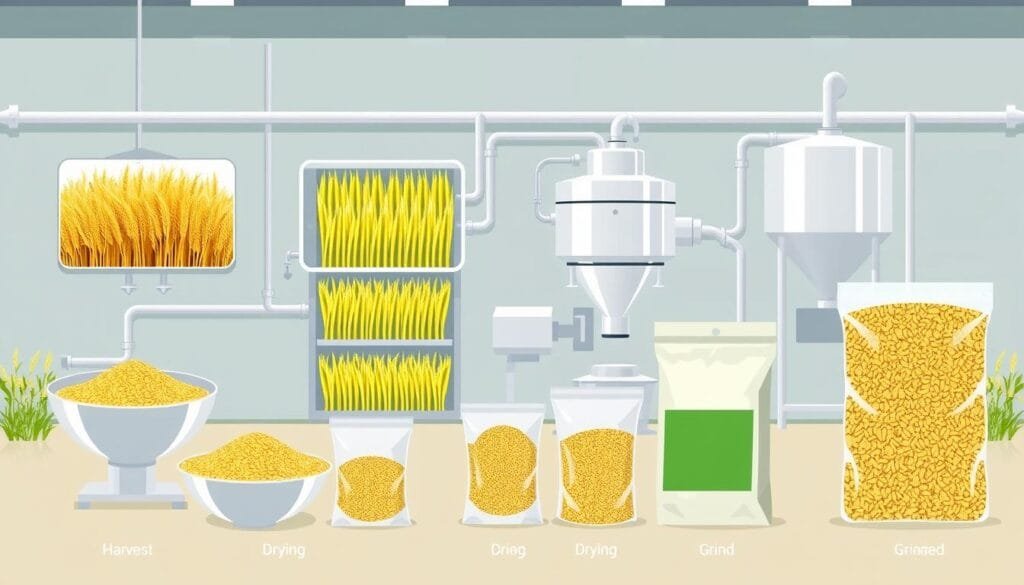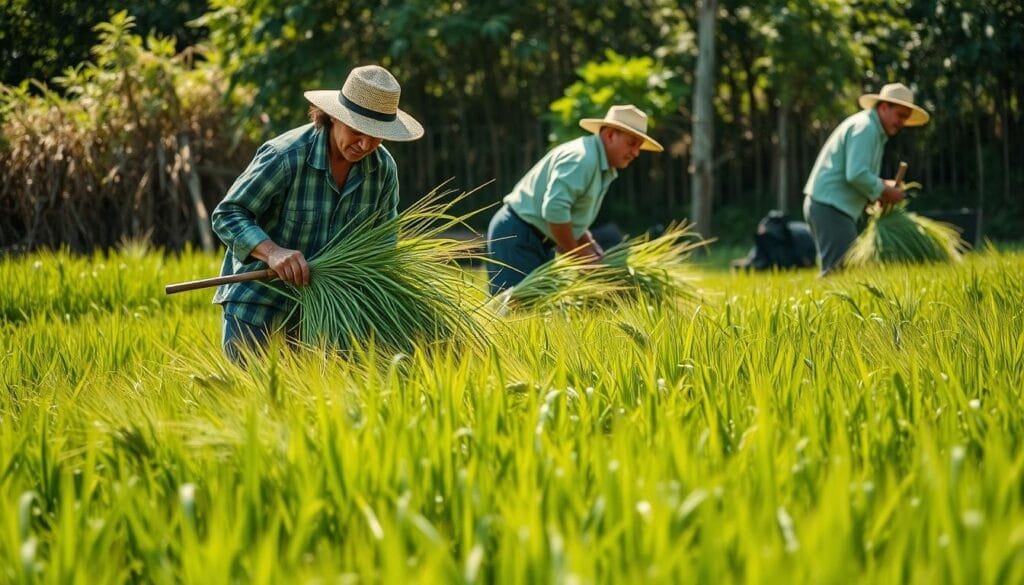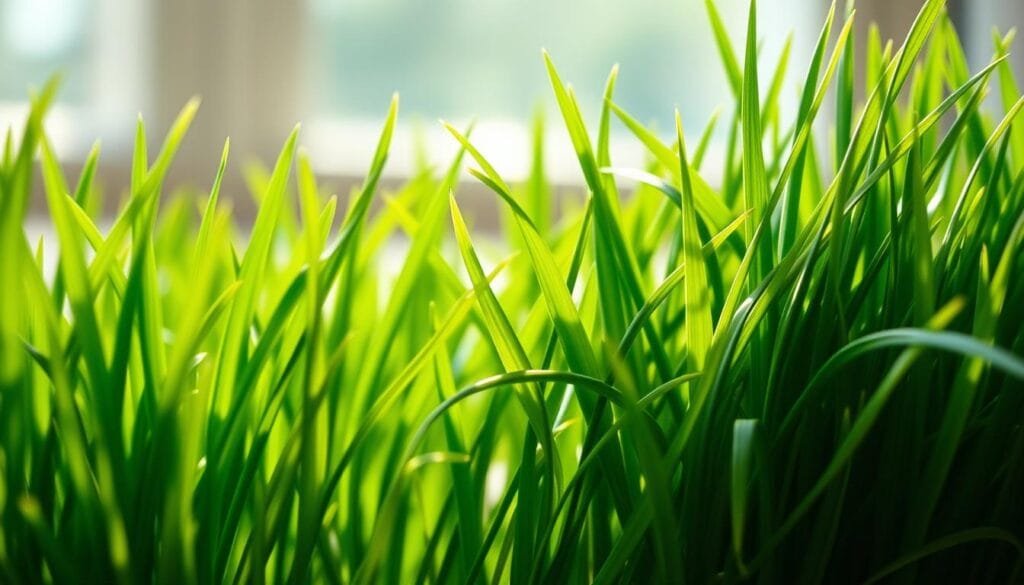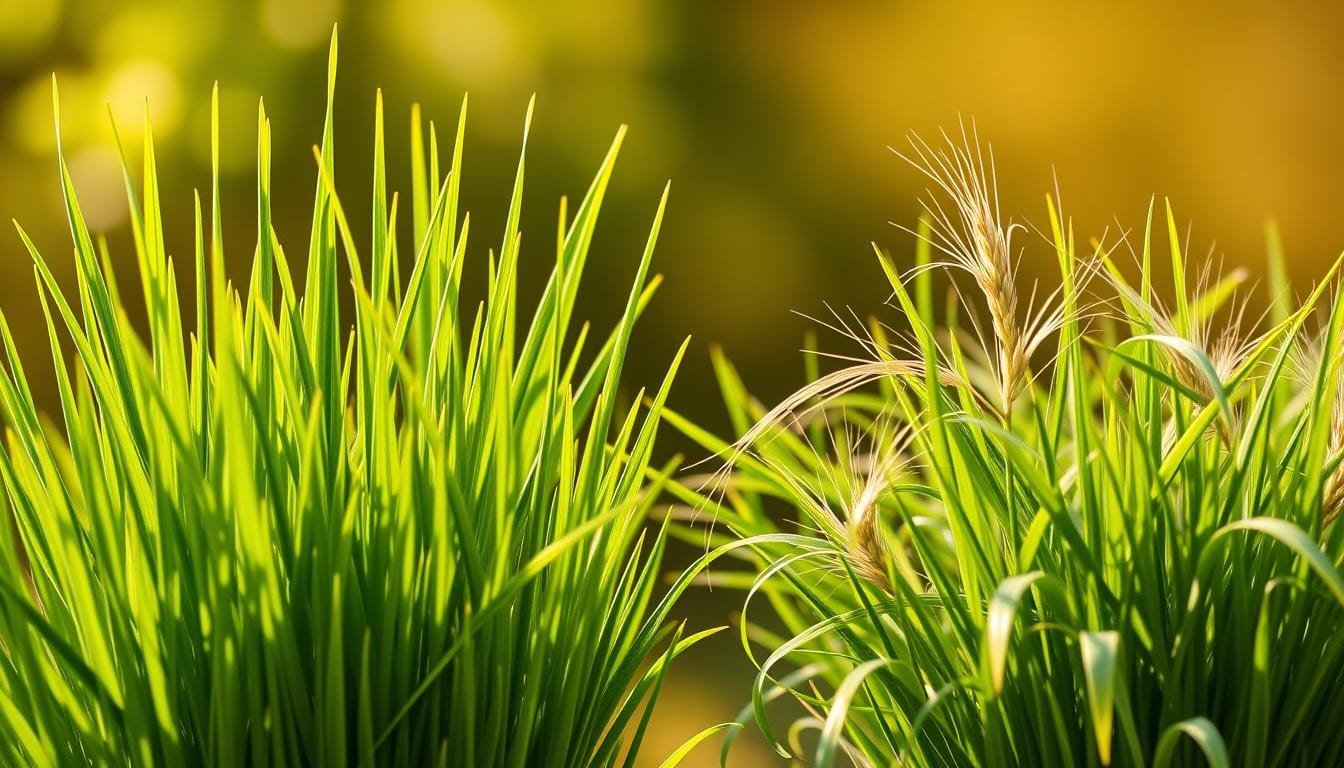Currently Empty: RM0.00
Are you torn between barley grass and wheatgrass supplements to boost your health?
In Malaysia’s growing health-conscious community, superfoods like barley powder and wheatgrass have gained popularity for their impressive nutritional profiles.
Both offer a rich source of antioxidants, chlorophyll, and essential nutrients, but distinct differences may make one more suitable for your needs.
At Wellness Concept, you can find premium quality barley grass products to enhance your health naturally.
Key Takeaways
- Understand the nutritional differences between barley grass and wheatgrass.
- Discover the health benefits of each superfood.
- Learn how to choose the best supplement based on individual health needs.
- Explore the suitability of each option for Malaysia’s climate and lifestyle.
- Find premium quality barley grass and wheatgrass products at Wellness Concept.
Understanding Superfoods in the Malaysian Context
With the rising awareness of health risks associated with processed foods and environmental pollutants, Malaysians are turning to superfoods for a solution. The concept of superfoods is not new, but their popularity has surged as people seek natural and effective ways to improve their health.
The Rising Popularity of Green Supplements in Malaysia
Green supplements, including green barley powder and wheatgrass, have gained significant traction in Malaysia. Their high nutritional value and potential health benefits make them an attractive option for those looking to enhance their well-being. The convenience of these supplements, coupled with their natural origins, has contributed to their growing popularity.
Why Malaysians Are Turning to Plant-Based Superfoods
Malaysians are turning to plant-based superfoods for various reasons. The increasing awareness of the health risks associated with processed foods and environmental pollutants in urban areas is a significant factor. Additionally, the growing interest in preventive healthcare approaches, particularly for common health concerns like diabetes, heart disease, and digestive issues, has driven the demand for natural solutions.
The traditional Malaysian medicine’s historical valuation of plant-based remedies has also created a cultural receptiveness to superfoods like barley grass and wheatgrass. These superfoods align with various dietary preferences in Malaysia’s multicultural society, including vegetarian, vegan, halal, and health-conscious diets.
| Superfood | Nutritional Benefits | Health Benefits |
|---|---|---|
| Green Barley Powder | High in chlorophyll, vitamins, and minerals | Detoxification, immune support, alkalizing |
| Wheatgrass | Rich in antioxidants, vitamins, and amino acids | Blood purification, energy boosting, antioxidant protection |
What Are Green Barley Powder and Wheatgrass?
Green barley powder and wheatgrass have gained popularity in Malaysia, but what exactly are they, and how are they made? Both are considered superfoods due to their high nutritional value.
Green Barley Powder: Origins and Processing

Green barley powder is derived from the young leaves of the barley plant. It is rich in vitamins, minerals, and antioxidants. The processing involves harvesting the young leaves, followed by drying and powdering them. This process helps retain the nutritional value.
Wheatgrass: Harvesting and Production Methods

Wheatgrass is the young grass of the common wheat plant (Triticum aestivum), harvested before the wheat grain forms, typically at 7-10 days after germination. It is packed with nutrients, including minerals, amino acids, B vitamins, enzymes, antioxidants, fiber, and chlorophyll. Wheatgrass can be grown indoors or outdoors and is usually harvested just once. For those interested in trying wheatgrass, you can find more information on Wellness Concept’s blog.
Nutritional Profile Comparison
Green barley powder and wheatgrass are both nutrient-dense superfoods, but their nutritional profiles reveal distinct differences.
Vitamin and Mineral Content
Both green barley powder and wheatgrass are rich in vitamins and minerals. Wheatgrass is known for its high content of vitamins A, C, and E, while barley grass contains a broader spectrum of minerals including calcium, iron, and potassium. The mineral content in barley grass is often considered more diverse, providing a wider range of nutritional benefits.
Protein and Amino Acid Composition
The protein content in both superfoods is significant, with barley grass containing a slightly higher amount of protein. The amino acid profile of barley grass is also more comprehensive, including essential amino acids that the body cannot produce on its own. Wheatgrass, however, still provides a good amount of protein and can be a valuable addition to a plant-based diet.
Antioxidant Properties and Chlorophyll Levels
The high antioxidant content in both green barley powder and wheatgrass can help Malaysians maintain cellular health and potentially slow aging processes accelerated by the tropical climate.
Health Benefits of Green Barley Powder
In the realm of superfoods, green barley powder stands out for its impressive nutritional profile and health benefits. Green barley powder is rich in essential nutrients and has been associated with various health benefits, making it a popular choice among health-conscious individuals in Malaysia.
Digestive Health and Detoxification Properties
Green barley powder is known to support digestive health due to its high fiber content and natural enzymes. It aids in detoxification by helping to remove toxins from the body, promoting a healthier digestive system. As stated by health experts, “A healthy digestive system is crucial for overall well-being, and green barley powder can play a significant role in maintaining it.”
Immune System Support and Anti-inflammatory Effects
The powder is rich in antioxidants and other nutrients that help boost the immune system and reduce inflammation. Regular consumption can lead to improved overall health and a reduced risk of chronic diseases. “The anti-inflammatory properties of green barley powder can be particularly beneficial in reducing the risk of diseases associated with chronic inflammation,” notes a recent health study.
Alkalizing Effects on the Body
One of the key benefits of green barley powder is its ability to alkalize the body. It has a high mineral content, including potassium, calcium, and magnesium, which help neutralize acidic compounds. Modern Malaysian diets often consist of processed foods, sugar, and animal proteins that can create excess acidity. Green barley powder helps balance the body’s pH levels, potentially leading to improved energy levels, better mineral absorption, and a reduced risk of chronic diseases. In Malaysia’s hot climate, where dehydration can concentrate acidic waste products, the alkalizing effects of green barley powder may be especially beneficial.
By incorporating green barley powder into their diet, Malaysians can complement their traditional foods, even those that may be acidic like spicy dishes, to maintain optimal pH balance for better overall health. As the body achieves a more alkaline state, individuals may experience enhanced well-being and a reduced susceptibility to various health issues.
Health Benefits of Wheatgrass
Wheatgrass is a nutrient-dense superfood that offers various advantages for overall well-being. Its high nutritional value makes it a popular choice among health enthusiasts in Malaysia.
Blood Purification and Oxygenation
The high chlorophyll content in wheatgrass acts as an antioxidant, helping to reduce oxidative stress and protect cells from damage. This process aids in blood purification and enhances oxygenation within the body.
Energy Boosting and Metabolism Enhancement
Wheatgrass contains enzymes like cytochrome oxidase, which aids in energy production and cellular respiration. This can lead to enhanced energy levels and a more efficient metabolism.
Antioxidant Protection and Free Radical Scavenging
Wheatgrass is rich in antioxidants, including vitamins C and E, which neutralize free radicals and prevent oxidative damage to cells. It also contains superoxide dismutase (SOD), with 303,000 units per 100 g, making it a potent antioxidant.
| Nutrient | Wheatgrass | Barley Grass |
|---|---|---|
| SOD (units per 100 g) | 303,000 | 146,000 |
| Chlorophyll Content | High | Moderate |

The antioxidant properties of wheatgrass may help protect Malaysians from premature aging and cellular damage caused by high UV exposure. Additionally, wheatgrass may help reduce inflammation markers in the body, potentially benefiting those with inflammatory conditions exacerbated by heat and humidity.
Green Barley Powder vs. Wheatgrass: Which Is Best for Malaysians?
Green barley powder and wheatgrass are both popular among Malaysians, but which one is more beneficial? To make an informed decision, it’s essential to consider several factors relevant to the Malaysian context.
Suitability for Malaysia’s Tropical Climate and Lifestyle
Malaysia’s tropical climate means high humidity and temperature, which can affect the shelf life and storage of superfoods. Green barley powder is more practical for long-term use due to its longer shelf life compared to wheatgrass, which is typically consumed fresh or frozen. This makes barley grass a more convenient option for many Malaysians.
Addressing Common Health Concerns Among Malaysians
Malaysians often face health concerns such as digestive issues and high levels of stress. Both green barley powder and wheatgrass offer detoxifying properties, but barley grass is particularly noted for its ease of digestion, making it suitable for those with weakened digestive systems.
How to Incorporate These Superfoods into Your Daily Routine
Green barley powder and wheatgrass are nutrient-rich superfoods that can easily be added to your daily routine for enhanced well-being. To get the most out of these supplements, it’s crucial to understand the proper ways to consume them.
Recommended Dosage and Consumption Methods
The recommended dosage for green barley powder is typically 1-2 teaspoons per day, mixed with water or juice. For wheatgrass, start with a small amount (about 1/2 ounce) and gradually increase to 1-2 ounces as your body adjusts. Both can be consumed on an empty stomach in the morning for maximum absorption.
Delicious Malaysian-Inspired Recipes
You can incorporate green barley powder into your favorite Malaysian smoothies, such as a banana-pineapple blend. For wheatgrass, try mixing it with coconut water and a squeeze of lime for a refreshing shot. These recipes not only taste great but also provide a boost of nutrients.
Potential Side Effects and Precautions
When first starting either superfood, some individuals may experience detoxification symptoms like mild headaches or digestive changes. These symptoms typically subside as the body adjusts. It’s also important to note that individuals with certain health conditions, such as those on blood-thinning medications, should consult their healthcare provider before consumption.
| Superfood | Recommended Dosage | Precautions |
|---|---|---|
| Green Barley Powder | 1-2 teaspoons/day | Consult if on blood-thinning medications |
| Wheatgrass | 1/2 to 2 ounces/day | Avoid if pregnant or breastfeeding |
Real Malaysian Experiences: Testimonials and Results
Malaysians from all walks of life are experiencing the transformative power of green superfoods. At Wellness Concept, we’re proud to share the success stories of our customers who have benefited from incorporating wheatgrass and green barley powder into their daily routines.
Transformations with Wheatgrass
Wheatgrass has been a game-changer for many Malaysians, boosting their immune systems and overall health. Siti, a 38-year-old teacher from Johor, struggled with recurrent colds and flu but experienced a significant strengthening of her immune system after three months of daily wheatgrass supplementation.
- David, a 45-year-old executive, found that wheatgrass improved his sleep quality and reduced anxiety symptoms.
- Mrs. Tan noticed remarkable improvements in her skin condition, including reduced eczema flare-ups.
- Farah, a young mother, used wheatgrass to boost her energy levels naturally while caring for her newborn.
Success Stories with Green Barley Powder
While specific testimonials for green barley powder are not detailed, the benefits of greens like green barley powder are well-documented. Many customers have reported improved digestion and overall wellbeing.
| Product | Customer | Benefits Experienced |
|---|---|---|
| Wheatgrass | Siti | Stronger immune system |
| Wheatgrass | David | Improved sleep, reduced anxiety |
| Wheatgrass | Mrs. Tan | Reduced eczema flare-ups |
Conclusion: Making the Right Choice for Your Health Needs
In summary, while both green barley powder and wheatgrass are beneficial, their different properties make one more suitable than the other for certain health concerns. Green barley powder excels in alkalizing properties and mineral content, making it ideal for digestive issues and sustained energy. On the other hand, wheatgrass offers superior detoxification and immune support, making it perfect for those seeking to boost their immune system and purify their blood.
For comprehensive nutritional support, consider alternating between both superfoods or using products that combine them. At Wellness Concept, we provide premium, pure, and potent versions of both green barley powder and wheatgrass. For personalized advice, consult with health professionals and contact us via WhatsApp (+60123822655) during our business hours for guidance on incorporating these superfoods into your Malaysian lifestyle.
FAQ
What are the key differences between Green Barley Powder and Wheatgrass?
Green Barley Powder and Wheatgrass differ in their nutritional profiles, with Green Barley Powder containing a broader range of vitamins, minerals, and antioxidants, while Wheatgrass is rich in chlorophyll and has potent detoxifying properties.
Are Green Barley Powder and Wheatgrass suitable for people with dietary restrictions?
Both Green Barley Powder and Wheatgrass are generally considered safe for individuals with dietary restrictions, as they are gluten-free, vegan-friendly, and hypoallergenic; however, it’s always best to consult a healthcare professional before adding any new supplements to your diet.
How do I choose between Green Barley Powder and Wheatgrass for my specific health needs?
Consider your individual health goals and needs; if you’re looking for a broad-spectrum nutritional boost, Green Barley Powder may be the better choice, while Wheatgrass is ideal for those seeking to support detoxification and blood purification.
Can I consume Green Barley Powder and Wheatgrass together?
Yes, you can consume both Green Barley Powder and Wheatgrass together, as they complement each other’s nutritional profiles and health benefits; however, start with a small dose and monitor your body’s response to avoid any potential interactions.
Are there any potential side effects or interactions associated with consuming Green Barley Powder or Wheatgrass?
While generally considered safe, some individuals may experience mild side effects such as digestive upset or allergic reactions; it’s essential to consult with a healthcare professional before consuming either supplement, especially if you have underlying health conditions or take medications.
How should I store Green Barley Powder and Wheatgrass to maintain their potency?
Store both Green Barley Powder and Wheatgrass in a cool, dry place, away from direct sunlight and moisture, to preserve their nutritional content and potency.



